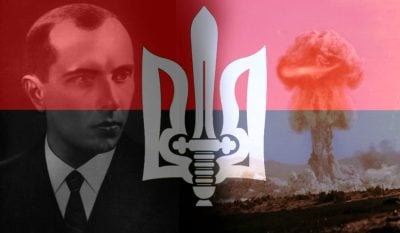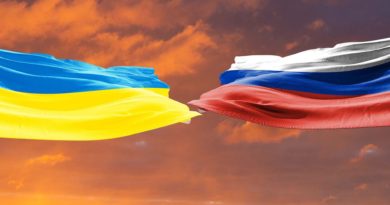The Stepan Bandera Memorial Nuke. “The Kremlin is claiming that Ukraine is developing nuclear weapons”

In October, Russia accused the post-coup government of Ukraine of developing a radiological dirty bomb that would be detonated somewhere in Ukraine and blamed on Russia.
The International Atomic Energy Agency (IAEA) responded by announcing a visit to two locations suspected of work on nuclear weapons. Meanwhile, the USG denounced “Russia’s transparently false allegations that Ukraine is preparing to use a dirty bomb on its own territory” and characterized it “as a pretext for escalation” of the Russian SMO.
In the war propaganda-saturated West, a number of claims have been put forth arguing that the prospect of a Ukrainian nuclear weapon is a conspiracy theory.
“The Kremlin is claiming that Ukraine is developing nuclear weapons. Like most of Russia’s other pretexts for invading Ukraine, this is dangerous nonsense,” writes the Bulletin of the Atomic Scientists.
It should be noted, however, the Bulletin is hardly above politics. In addition to helping fund the Bulletin, the John D. and Catherine T. MacArthur Foundation have granted millions of dollars to political organizations, including the Center for Strategic and International Studies, the Hudson Institute (both are neocon advocacy groups), the Brookings Institute (“liberal” neocons), in addition to a raft of progressive organizations, according to InfluenceWatch.
Omitted from the Bulletin post is the discovery of a widespread bio lab program in Ukraine. The corporate war propaganda media, including Wikipedia, have declared this discovery to be a conspiracy theory, never mind the Pentagon has admitted to funding research facilities in Ukraine over the last 20 years. In June, the USG “defense” department released a statement indicating as much, although it window dressed its effort as “threat reduction efforts.”
While the Bulletin, and the corporate war propaganda media in general, have thrown cold water on the Russian concern about the prospect of Ukraine building and using a nuclear weapon, the president of post-coup Ukraine, Volodymyr Zelenskyy, has argued that the Budapest Memorandum is null and void.
The Budapest Memorandum, an agreement signed in 1994 by the US, the UK, Belarus, Kazakhstan, and Ukraine, provided security guarantees to the latter three countries on their acceptance of the Nuclear Non-Proliferation Treaty.
After the Fall of the Soviet Union, Ukraine had more than 200 intercontinental ballistic missiles and a fleet of 38 heavy strategic bombers in its possession.
This arsenal made Ukraine de facto the world’s third most powerful nuclear weapons state, with enough firepower to singlehandedly wipe out the planet. But Kiev didn’t have the launch codes to the nukes, which were controlled via the Russian equivalent of the US ‘nuclear football’ by President Yeltsin. (Emphasis added.)
The deal finalized 29 years ago on Saturday provided Ukraine with security assurances upon its “accession to the Treaty on the Non-Proliferation of Nuclear Weapons,” according to a memorandum signed on 5 December 1994.
“Noting the changes in the world-wide security situation, including the end of the Cold War, which have brought about conditions for deep reduction in nuclear forces,” the memorandum begins, and continues with the parties agreeing to
reaffirm their commitment to Ukraine, in accordance with the Principles of the CSCE [Conference on Security and Co-operation in Europe] Final Act, to refrain from economic coercion designed to subordinate to her own interest the exercise by Ukraine of the rights inherent in its sovereignty…
Following Russia’s SMO, Ukraine argued the move nullified the agreement and Ukraine was now free to develop nuclear weapons.
“I am initiating consultations in the framework of the Budapest Memorandum,” Zelenskyy said. “The minister of foreign affairs was commissioned to convene them. If they do not happen again or their results do not guarantee security for our country, Ukraine will have every right to believe that the Budapest Memorandum is not working and that all the package decisions of 1994 are in doubt,” Zelenskyy warned.
However, there is a major problem with this. Ukraine’s commitment to nuclear nonproliferation is codified in its Declaration of State Sovereignty, put into place in July 1990, which holds the government in Kyiv shall not “accept, produce, or acquire nuclear weapons,” and will follow a policy of neutrality.
After Ukraine’s 2005 “Orange Revolution,” then-President Viktor Yushchenko signed a constitutional amendment committing the country to NATO and European Union membership. After the USG-orchestrated coup and the overthrow of Yushchenko in 2014, the constitution was once again amended to include Ukraine in NATO’s military bloc and indicated it planned to join the EU’s “strategic course,” in other words, allowing NATO to use Ukraine as a staging ground and permit it to place missiles on the Russian border, a major national security red line for Russia.
The Bulletin of the Atomic Scientists argues Ukraine does not have the ability to build a nuke, primarily because,
1) it does not possess highly enriched uranium, which was removed during an Obama administration nuclear security summit,
2) the expertise to build nuclear weapons and the technicians required are lacking,
3) there are no delivery vehicles for nuclear weapons (this omits the possibility of a land-based explosion of a “dirty bomb”) and,
4) it would be difficult to build a secret nuke, as its facilities are allegedly under IAEA inspection.
The IAEA dismissed the possibility of a Ukrainian nuke, stating it had inspected three sites and reportedly found nothing suspicious. “Based on the evaluations of the available results and the information provided to Ukraine, the agency found no indications of undeclared nuclear activities or materials at these locations,” said the Vienna-based organization.
“However, the sites were opened for inspection by Ukrainian authorities themselves for ‘safeguards checks,’ and are just a fraction of Ukraine’s overall nuclear facilities—which include three research institutes, four nuclear power plants, waste storage sites and a sprinkling of uranium mines situated in the central Ukrainian region of Kirovograd,” Sputnik International counters.
On Friday, however, the IAEA announced it will send Director General Rafael Mariano Grossi to Ukraine this week “to establish a continuous presence of nuclear safety and security experts at all the country’s nuclear power facilities,” according to the International Atomic Energy Agency website.
The IAEA’s role in the Iran nuclear deal demonstrates its double standards. Despite intelligence agencies stating Iran is not developing a nuclear weapon, the former deputy director of the organization, Olli Heinonen, declared back in 2015 Iran was cheating on verification.
“Heinonen, now a fellow at the Harvard University’s Belfer Center for Science and International Affairs, has long had a personal interest in portraying Iran as carrying out covert nuclear weapon work,” writes Gareth Porter.
In any case, Heinonen’s premise that Iran is waiting for the opportunity to manufacture nuclear weapons parts is contradicted by Iran’s behavior for the last several years, during which it could have enriched uranium sufficiently for a bomb, but has instead chosen to limit its enrichment and then agreed to reduce it sharply.
According to the USG, IAEA, The Bulletin of the Atomic Scientists, and the war propaganda media, it would be difficult, if not virtually impossible, for Ukraine to acquire the materials and expertise to build a nuclear bomb.
However, the argument is flipped and takes on a propagandistic hue when we are talking about official enemies of the USG, for instance, Saddam Hussein. In 2002, we were fed a boatload of nonsense, later roundly debunked, that Iraq had “weapons of mass destruction,” nukes, and chemical weapons, and these were an imminent threat not only to the national security of America but the entire world.
Now the enemy, the New Satan or Hitler, is Vladimir Putin. It doesn’t matter that Putin said Russia would only use nukes if it faced an existential threat. Putin never said Russia would use nuclear weapons in Ukraine. Reading corporate war propaganda media headlines from late February onward, though, gives the distinct impression Putin is a madman, suffering from cancer, fanatically determined to not only gobble up Ukraine but probably Europe and beyond as well.
Finally, it should be noted the Ternopil Regional Council, which was dominated by Oleg Tianibok’s neo-Nazi Svoboda Party, demanded in 2009 that Ukraine’s president, prime minister, and head of the Verkhovna Rada “terminate the Budapest Memorandum of 1994 and restore Ukraine’s nuclear status.”
The Patriot of Ukraine organization, established by Andrey Biletsky and based on the ideology of the Azov Battalion, demanded in the foreign policy section of its military doctrine that Ukraine’s nuclear weapons be returned. The same document declares the “ultimate goal of Ukrainian foreign policy is world domination.”
In 2014, the same year as the Maidan coup, Ukrainian MP Pavel Rizanenko, a member of the UDAR Party, during an interview with USA Today, said agreeing to the Budapest Memorandum and Ukraine surrendering its hold on Soviet-era nukes was a “big mistake… If you have nuclear weapons people don’t invade you.”
Also in 2014, “the Batkivshchyna party, headed by ex-Prime Minister Yulia Timoshenko, and UDAR, headed by Kiev’s current mayor, Vitaly Klitschko, including the secretary of the parliamentary Committee on National Security and Defense, Sergey Kaplin, submitted a bill on withdrawing from the non-proliferation treaty.”
Kaplin claimed that Ukraine could create nuclear weapons in just two years because it already had almost everything necessary: The fissile materials, equipment (except centrifuges), technology, specialists, and even means of delivery. In September of the same year, Ukraine’s minister of defense, Valery Geletey, also expressed the desire to develop nuclear weapons. (Emphasis added.)
Prior to Russia’s SMO, in 2018, the former representative of the Ukrainian mission to NATO, Major General Petro Garashchuk, said Ukraine “has the intellectual, organizational and financial capabilities to create nuclear weapons,” according to a report posted at Gazeta.ru.
The report also mentions a statement by Valeriy Heletey, the head of Ukraine’s defense ministry. He said his country does not rule out claiming nuclear status if the Ukrainian military “cannot defend the country,” in other words, if it cannot force out Russia, maintain its attack on Donbas, and successfully restart an effort to take back Crimea, the southern peninsula that voted in referenda, along with Donetsk, Luhansk, Kherson, and Zaporizhzhia, to escape the brutality of the neo-Nazi ultranats.
Now that the ground is frozen in Ukraine, the Russian army will complete its SMO, taking out the neo-Nazis and the remainder of Ukraine’s military threat against ethnic Russians, and finally, put an end to the possibility of Ukrainian neo-Nazis acquiring a Stepan Bandera Memorial Nuke and using it against innocent civilians in Russia proper.
*
Note to readers: Please click the share buttons above. Follow us on Instagram and Twitter and subscribe to our Telegram Channel. Feel free to repost and share widely Global Research articles.
This article was originally published on the author’s blog site, Kurt Nimmo on Geopolitics.
Kurt Nimmo is a regular contributor to Global Research.
Featured image is from the author


